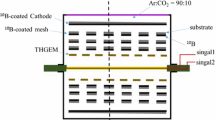Abstract
Boron-lined gaseous neutron detectors are being widely used in neutron detection to replace 3He proportional counters, and the boron film’s parameters comprise the key factors influencing the performance of such detectors. However, the method of characterizing boron film is relatively simple at present. In this study, boron films stuck to ultrathin glass substrate with different mass proportions of epoxy to natural boron (MPENBs) were prepared. A variety of characterization methods, including scanning electron microscopy, energy-dispersive X-ray spectroscopy, white-light interferometry, and multiple tape tests, were used to test the boron films simultaneously, and the test results are discussed herein. Moreover, neutron imaging was conducted to analyze the uniformity of boron-10 atoms. These characterization results demonstrate that the optimized MPENB formulation is 0.16 with the boron atomic ratio of chemical elements (ARCE) at approximately 68.8% and surface roughness Sa = 1.457 μm and that the structure of boron film is uniform and fluffy, contributing to improving the boron-lined method.










Similar content being viewed by others
References
A.T. Lintereur, R.T. Kouzes et al., Office of scientific & technical information technical reports, vol. 1 (2009), p. 18938
A.T. Simone, C. Stephen et al., IEEE Trans. Nucl. Sci. 1, 10 (2017)
C.M. Quick, A. Marvin et al., Texas A&M University, vol. 1 (2018), p. 1
Y. Seki, A. Taketani et al., Nucl. Instrum. Methods A. 148, 870 (2017)
B.M. Van Der Ende, J. Atanackovic et al., Nucl. Instrum. Methods A. 40, 820 (2016)
M. Anastasopoulos, R. Bebb et al., JINST. 12, P04030 (2017)
F. Piscitelli, G. Mauri et al., JINST. 13, P05009 (2018)
C. Deng, X.G. Tuo et al., IEEE Nucl. Sci. Symp. Conf. Rec. 1, 978 (2009)
G. Mauri, I. Apostolidis et al., JINST. 15, P03010 (2020)
L.M.S. Margato, A. Morozov et al., JINST. 15, P06007 (2020)
D.A. Shea, D. Morganet et al., Congressional Research Service, vol 7 (2011), p R41419
A.M. Arkharov, I.A. Arkharov et al., Chem. Pet. Eng. 1, 49 (2013)
A.J. HurdAlan, R.T. Kouzeset, Eur. Phys. J. Plus. 129, 236 (2014)
G. Croci, A. Muraro et al., EPL 123, 52001 (2018)
E. Azizov, V. Barsuk et al., J. Nucl. Mater. 463, 792 (2015)
B. Clement, A. Bes et al., JINST. 14, P09003 (2019)
N.S. Edwards, K.A. Nelson et al., Nucl. Instrum. Methods A. 85, 898 (2018)
Q.X. Feng, R.Z. Qi et al., Infrared Laser Eng. 48, S217001–S217011 (2019)
C. Hglund, J. Appl. Phys. 111, 778 (2012)
Z. Fang, C. Deng et al., JINST. 14, P12003 (2019)
H.Y. Huo, H. Li et al., Nucl. Instrum. Methods A. 953, 163063 (2020)
J. Guapacha, E.M. Vallés et al., Polym. Bull. 74, 2297 (2017)
Acknowledgements
This research was supported in part by the National Natural Science Foundation of China (Nos. 42004151 and 41904162) and in part by the Sichuan Science and Technology Program (No. 2021JDRC0011) and the Open Foundation of Artificial Intelligence Key Laboratory of Sichuan Province (No. 2020RZJ01). We thank the Institute of Nuclear Physics and Chemistry, China Academy of Engineering Physics, for providing the neutron imaging test. We thank Professor Yang Yigang of Tsinghua University for providing the valuable recommendation of using boron-lined method.
Author information
Authors and Affiliations
Corresponding author
Additional information
Publisher's Note
Springer Nature remains neutral with regard to jurisdictional claims in published maps and institutional affiliations.
Rights and permissions
About this article
Cite this article
Deng, C., Wang, Q., Wu, Y. et al. Preparation and characterization of boron films used for boron-lined gaseous neutron detectors. J. Korean Phys. Soc. 79, 606–612 (2021). https://doi.org/10.1007/s40042-021-00256-2
Received:
Revised:
Accepted:
Published:
Issue Date:
DOI: https://doi.org/10.1007/s40042-021-00256-2




